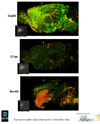The genomic determinants of alcohol preference in mice
- PMID: 18563486
- PMCID: PMC2583933
- DOI: 10.1007/s00335-008-9115-z
The genomic determinants of alcohol preference in mice
Abstract
Searches for the identity of genes that influence the levels of alcohol consumption by humans and other animals have often been driven by presupposition of the importance of particular gene products in determining positively or negatively reinforcing effects of ethanol. We have taken an unbiased approach and performed a meta-analysis across three types of mouse populations to correlate brain gene expression with levels of alcohol intake. Our studies, using filtering procedures based on QTL analysis, produced a list of eight candidate genes with highly heritable expression, which could explain a significant amount of the variance in alcohol preference in mice. Using the Allen Brain Atlas for gene expression, we noted that the candidate genes' expression was localized to the olfactory and limbic areas as well as to the orbitofrontal cortex. Informatics techniques and pathway analysis illustrated the role of the candidate genes in neuronal migration, differentiation, and synaptic remodeling. The importance of olfactory cues, learning and memory formation (Pavlovian conditioning), and cortical executive function, for regulating alcohol intake by animals (including humans), is discussed.
Figures

Similar articles
-
Genetical genomic determinants of alcohol consumption in rats and humans.BMC Biol. 2009 Oct 27;7:70. doi: 10.1186/1741-7007-7-70. BMC Biol. 2009. PMID: 19874574 Free PMC article.
-
Critical evaluation of transcription factor Atf2 as a candidate modulator of alcohol preference in mouse and human populations.Genet Mol Res. 2013 Nov 26;12(4):5992-6005. doi: 10.4238/2013.November.26.9. Genet Mol Res. 2013. PMID: 24338393 Free PMC article.
-
A systems genetic analysis of alcohol drinking by mice, rats and men: influence of brain GABAergic transmission.Neuropharmacology. 2011 Jun;60(7-8):1269-80. doi: 10.1016/j.neuropharm.2010.12.019. Epub 2010 Dec 23. Neuropharmacology. 2011. PMID: 21185315 Free PMC article.
-
Identifying genes for alcohol and drug sensitivity: recent progress and future directions.Trends Neurosci. 1999 Apr;22(4):173-9. doi: 10.1016/s0166-2236(99)01393-4. Trends Neurosci. 1999. PMID: 10203855 Review.
-
Gene discovery and the genetic basis of calcium consumption.Physiol Behav. 2008 Aug 6;94(5):649-59. doi: 10.1016/j.physbeh.2008.04.004. Epub 2008 Apr 13. Physiol Behav. 2008. PMID: 18499198 Free PMC article. Review.
Cited by
-
The neurobiology of alcohol consumption and alcoholism: an integrative history.Pharmacol Biochem Behav. 2013 Nov 15;113:20-37. doi: 10.1016/j.pbb.2013.10.009. Epub 2013 Oct 17. Pharmacol Biochem Behav. 2013. PMID: 24141171 Free PMC article. Review.
-
Scn4b regulates the hypnotic effects of ethanol and other sedative drugs.Genes Brain Behav. 2019 Jul;18(6):e12562. doi: 10.1111/gbb.12562. Epub 2019 May 2. Genes Brain Behav. 2019. PMID: 30817077 Free PMC article.
-
Ethanol modulation of gene networks: implications for alcoholism.Neurobiol Dis. 2012 Jan;45(1):115-21. doi: 10.1016/j.nbd.2011.04.013. Epub 2011 Apr 22. Neurobiol Dis. 2012. PMID: 21536129 Free PMC article. Review.
-
Effects of embryonic ethanol exposure at low doses on neuronal development, voluntary ethanol consumption and related behaviors in larval and adult zebrafish: Role of hypothalamic orexigenic peptides.Behav Brain Res. 2016 May 1;304:125-38. doi: 10.1016/j.bbr.2016.01.013. Epub 2016 Jan 8. Behav Brain Res. 2016. PMID: 26778786 Free PMC article.
-
Stress-response pathways are altered in the hippocampus of chronic alcoholics.Alcohol. 2013 Nov;47(7):505-15. doi: 10.1016/j.alcohol.2013.07.002. Epub 2013 Aug 24. Alcohol. 2013. PMID: 23981442 Free PMC article.
References
-
- American Psychiatric Associaton. Diagnostic and Statistical Manual of Mental Disorders. 4 ed. Washington, DC: American Psychiatric Association; 1994.
-
- Anderson AK, Christoff K, Stappen I, Panitz D, Ghahremani DG, Glover G, Gabrieli JD, Sobel N. Dissociated neural representations of intensity and valence in human olfaction. Nat Neurosci. 2003;6:196–202. - PubMed
-
- Belknap JK, Belknap ND, Berg JH, Coleman R. Preabsorptive vs. postabsorptive control of ethanol intake in C57BL/6J and DBA/2J mice. Behav Genet. 1977;7:413–425. - PubMed
-
- Benjamini Y, Hochberg Y. Controlling the false discovery rate: a practical and powerful approach to multiple testing. JR Statist Soc B. 1995;57:289–300.
Publication types
MeSH terms
Grants and funding
LinkOut - more resources
Full Text Sources
Medical
Molecular Biology Databases

